


Chapter 2 has described some of the problems which can occur when conventional FMPs are applied in collective forest management situations. Most of these stem from the inappropriate nature of conventional FMPs in the newer environment of participatory forestry and collective forest management. Recognition of this has led to a series of attempts to modify FMP formats for both collective forest management, and for individual small-scale forest owners. Successes with these adaptations have been mixed, but all can be described as being simpler or more appropriate versions of conventional FMPs (whether or not they are actually described as such).
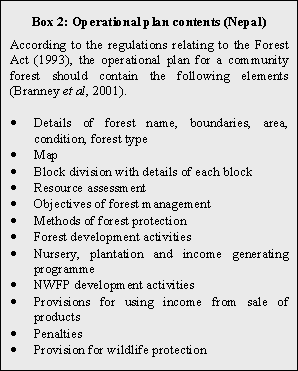

As Boxes 2 and 3 show, the term “simpler” is a relative term. In this case, an operational Plan for a community forest in Nepal (Box 2) although not specifically described as “simpler”, in practice appears much simpler than the “Simpler Forest Management Plan” used in Guatemala (Box 3).
The term “simpler” needs to be treated with some caution to avoid misinterpretation. Although the actual FMP (the final document) in many CFM situations needs to be simpler than a conventional FMP (as per Chapter 2), the same may not necessarily be true for the process that results in its successful formulation. This can be a complex participatory process aimed at reaching consensus between diverse stakeholder groups and regarding a number of different (and sometimes contradictory) management objectives. It would therefore be ill-advised to treat such a participatory process as being simple when compared with a conventional, technically-driven planning process since this would underestimate the skills and time required to facilitate it. The collective forest management situation can therefore require the apparent contradiction of a simpler type of FMP which is the outcome of a relatively more complex process.
Several types of FMP for small-scale or CFM situations can be distinguished depending on the overall forest management objectives and the type of forest manager:
• forest management plans for livelihood-oriented forestry
• forest management plans for commercial forest enterprises
• forest management plans for small-scale private forest owners
Whilst these three types of plan are not mutually exclusive (e.g. the livelihoods-oriented and forest enterprise types are commonly combined within a single collectively managed forest), they can be conveniently used to analyse different experiences with simpler FMPs. The examples given show that there have been significant attempts to modify conventional FMPs to accommodate these new requirements. Within these modifications there is much variation in the type and degree of simplification which has taken place. Some characteristics of these simpler FMPs and the type of support being provided to prepare and implement them are summarized in Fig. 1.
Analysis of experiences with simpler FMPs has been divided into several key areas covering the most important developments (again these are shown in Fig. 1).
Fig. 1: Summary of the characteristics of “simpler” FMPs and management planning support | ||
Characteristics |
Examples used | |
3.2 Livelihood-oriented CFMs | ||
3.2.1 Appropriate legislation |
Probationary period; use of by-laws; use of environmental standards; emphasis on social criteria; recognition of existing indigenous institutions |
• The Gambia • Tanzania • Bolivia • Nepal |
3.2.2 Autonomously evolved plans |
Iterative learning within communities; accountability and transparency mechanisms in decision-making and benefit sharing; strong leadership; driven from a sense of “crisis” |
• Jadhargaon & West Bengal (India) • Tianba (China) |
3.2.3 Simpler plans |
Non-technical; map-based approach; participatory methods; minimal information requirements; simple silvicultural models |
• Cameroon • Bhutan |
3.2.4 Simpler planning techniques |
Multi-purpose forest management; use of indigenous knowledge; forest-user-led experiments; participatory resource assessment; simple tools and equipment |
• Agroforests (Indonesia) • Forest Management Learning Groups (Nepal & Vietnam) • Kenya • Nepal |
3.3 Enterprise-oriented CFMs | ||
3.3.1 Appropriate legislation |
Marketing support by government (few examples) |
|
3.3.2 Autonomously evolved plans |
Spin-off of from livelihood-oriented self-rule of local forests; formalization of existing forest-use rights for timber |
• CFMGs (Bhutan) |
3.3.3 Simpler plans |
Non-technical; map-based approach; participatory methods; minimal information requirements; simple silvicultural methods |
|
3.3.4 Simpler planning techniques |
Supporting forest-user-led analysis; emphasis on resource sustainability; market sustainability, social/institutional sustainability and technical sustainability |
• Marketing Analysis and Development Approach |
3.4 Individual Small-scale Forest Managers | ||
3.4.1 Appropriate legislation |
Applied to small forests only, use of simple sketches in place of a pre-harvest inventory |
• Bolivia, Guatemala |
3.4.2 Simpler planning techniques |
Multi-purpose forest garden planning, joint marketing support, micro credit and certification support |
• Analog Forestry, Bhutan |
For each of the three type of management plan identified, the following characteristics have been used as a means of classifying experiences and examples:
Appropriate legislation |
What has been done to legislate for more appropriate forest management plans for collective forest managers? |
Autonomously evolved plans |
How have local communities been able to learn and develop planning techniques which meet their own needs and capacities? |
Simpler plans |
What plan structures have been developed to be consistent with the need for simpler forest management plans? |
Simpler planning techniques |
What simpler planning techniques are being used to support the active participation of local communities in forest management planning? |
Legislation which accompanies or supports simpler FMP formats for CFMs (or for individual small-scale forest managers) has been developed in many countries including: Cameroon, Gambia, Tanzania, Mozambique, Malawi, Kenya, Senegal, Mexico, Costa Rica, Guatemala, Bolivia, Brazil, Paraguay, Chile, Argentine, Cambodia, Vietnam, Laos, Philippines, Nepal, Indonesia, Myanmar and Bhutan. Many of these countries have already officially accommodated simpler FMP formats for CFMs in their legislation although the level of planning still tends to be based on the requirements for commercial forest enterprises, regardless of the actual management objectives.
Most of the formats of FMPs presented here are still complicated from the small-scale managers’ point of view and require technical assistance from professional foresters. Only a few countries so far have legal provisions specifically tailored to livelihood-oriented small-scale forest management.
The examples described here from Gambia and Tanzania illustrate how appropriate legislation can be used to support a type of FMP which is appropriate to the requirements of CFMs where the overall management objective is to benefit the livelihoods of rural forest users. The example from Nepal shows how over-prescriptive legislation can have a negative impact.
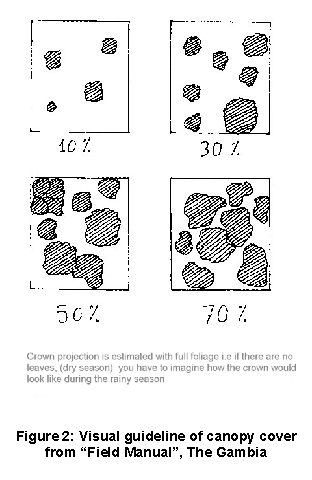
In Gambia, the Forest Bill (1998) defines the procedures and legal requirements for creation of community forests and designation of community controlled state forests. The accompanying “Field Manual on Community Forestry Start-up and Implementation” (referred as “Field Manual”) was issued by the Community Forestry Unit of the Forestry Department. In this manual, planning requirements for community forests are drastically simplified. Examples of simpler procedures for harvesting, resource assessment and management agreements are described here:
A: Simple harvest guidelines
These are based on canopy cover % instead of an annual allowable cut for which inventory would be needed. With canopy cover less than 30 % no live tree harvesting is allowed. If canopy cover is more than 30 % and if the trees are non-valuable species27 then exploitation can take place providing canopy closure remains above 30% (Fig.2).
For valuable species, exploitation is possible but has to follow a simple diameter limit for felling, regeneration and density of standing trees28. The use of such simple criteria for harvest greatly eases enforcement and monitoring by forest guards.
B: Resource assessment
Inventory is not required in the 3-year and 5-year management plan29 which the Forest Committees30 have to develop. This reduces the burdens (in terms of labour, costs and technical skills) which the Forest Committees have to bear. As an alternative, a map31 is required for forest management planning purposes and the existing forest resource is assessed through Resource Mapping based on Participatory Learning and Action (PLA) exercises including transect walks and participatory mapping.
C: Management agreement
The Community Forest Management Agreement (CFMA) is developed through a two-tier process consisting of a Preliminary Community Forest Management Agreement (PCFMA), followed by a 5-year Community Forest Management Agreement (CFMA). The former is a 3-year probation period before the official handover gives permanent ownership rights over forest resources and serves as a period for institution building; management planning; capacity building and confidence building of both parties (local Forest Committee and the Forest Department).
The CFMA consists of brief descriptions32 of anticipated forest management operations for the next 5 years; responsibility for each of the operations and information about the committee members. Local by–laws are established as a legal instrument for supporting implementation of the management plan. The manual recognizes the traditional importance and advantage of oral by-laws and endorses their use in a flexible way. It also recognizes that local forest management rules (officially called as Community Forestry Rules) will emerge gradually through a process of awareness creation and cannot be established at once. Local forest management rules are expected to contain regulations allowing restricted access to and use of the community forest and its products by determining the users; the products to be used, and the use systems.
After the CFMA has been signed by both parties, a cadastral survey is carried out by the Survey Department and the forest is then officially gazetted by Parliament. This assures the community’s permanent tenure of the forest. Finally, the Bill does not set a maximum ceiling33 for forest managed under CFMA. This legislation is particularly remarkable when compared with other relatively complex procedures applicable in very small forests of 3-5 ha e.g. in Bolivia and Guatemala.
A: Legislation34
In Tanzania the elected village council of each village is designated as ‘Land Manager’ with powers to adjudicate, allocate, register and certificate landholding within the village area through the establishment of a Village Land Registry. The law directly encourages the establishment of village forest reserves as a priority by requiring each village to register such common resources prior to allocation of remaining land to individuals. National Forest Policy (1998) then directs that village forest reserves will be managed by village governments or other entities designated by them for this purpose e.g. NGOs, user groups, associations, and religious institutions. Therefore, the legislative system for village forest reserves in Tanzania recognizes previously established local governance frameworks and bodies – village governments – and enhances their legal powers to make by-laws affecting the use and management of forest resources within the village area (Wily, 1999).
Community-based Forest Management (CBFM) in Tanzania does not therefore aim for community “participation” but to be community-based. Devolved decision-making supports the empowerment of forest-dependent people where, in this situation, foresters participate in the efforts of the communities who are recognized as the actual forest managers. This management-centred rather than user-centred approach of CBFM is reflected in the forest management planning process specified in the official “Community-based Forest Management Guidelines (CBFM Guidelines)”.
B: Planning Guidelines
According to these guidelines, communities must prepare a forest management plan (FMP) and draft and pass a set of village by-laws. The community appoints a “planning team” to support this process. Using a set of questions provided in the CBFM Guidelines35 the planning team inspects the forest thoroughly although no quantitative forest inventory is required. This inspection allows the community to decide what kind of management regime it needs.
C: Forest Management Plan Format
The FMP format is provided in the CBFM Guidelines. To be approved, a FMP does not need to contain more than a simple list of actions36 with timetable for rehabilitation and development of the forest. The FMP defines the responsibilities and powers of each actor with control systems in place for each task described in the plan to ensure accountability and transparency. Plans therefore focus on boundaries, rules (officially established as by-laws), punishments and monitoring arrangements, rather than on a detailed silvicultural prescriptions.
A “test period” of at least 1 year is required (with a Provisional Forest Management Plan for this period) before registering a Village Forest Reserve (VFR) or signing a Joint Management Agreement and by-laws37. A “review team” appointed by the community reviews financial management, record-keeping, reporting, forest protection, adherence to the rules, enforcement of punishment, the status of boundary disputes and the views of various local stakeholders on the forest management. Checklists specified in CBFM Guidelines are used to identify questions to ask under “Things to look for”38. Using these, problem areas are identified, and decisions are made to address them. The FMP is re-drafted according to these and is finalized for the formalization of CBFM.
In Nepal, where community forestry is now well established, national level operational guidelines were produced in 1995 and revised in 2002 based around the Forestry Act (1993) which legislated for the establishment of community forests managed by forest user groups. These guidelines were highly process-oriented reflecting the importance given to a participatory planning process involving all local stakeholders (forest users) in operational plan preparation. Although not without problems, the overall impact of these guidelines has been to strengthen participatory processes; to enable community forestry as a national-level and widespread programme; and to empower forest user groups.
Unfortunately, more recent developments have tended to weaken rather than build on this strong enabling environment. Recently produced inventory guidelines for community forests39 have now prescribed a conventional forest inventory approach despite a number of successful initiatives where participatory resource assessment and forest users involvement in a non-technical and understandable way have been piloted. In practice, the spirit of the operational guidelines are undermined by these newer inventory prescriptions. The result has been that both forest user groups and supporting field staff (forest guards and forest rangers) have to carry out a task in order to revise their operational plans for which they not only lack capacity and resources, but for which there is little real demand. Unsurprisingly, in many districts this has led to a huge backlog of plans requiring revisions and a reduced levels of confidence amongst forest user groups.
Domestic use of forests in Bolivia do not require authorization40, whilst a forest management plan is an essential requirement for all types of commercial forestry (Pacheco, 2001). Domestic use is regulated by the agreement instituted through negotiations between the local communities and/or other landowners co-ordinated by the local municipalities and local forest office (La Superintendencia Forestal). The agreement takes into consideration specific characteristics of the area, traditional use and customs, and sustainability of the resource. A distinction has therefore been made in the legislation which promotes the no-commercial use of forest.
Traditional local forest governance systems are encountered throughout the world. These are usually based on simple environmental and social codes developed by local people within their traditional/local institutional structures. Often, such systems forest are not officially recognized by governments or accommodated within forestry-related laws.
Local forest governance systems can work effectively - especially where there is limited external pressure (e.g. logging/mining companies; excessive interference by central government). In the face of such pressures, strengthening existing systems and processes can be more effective than imposing new ones. Hence, this section looks at examples where forest management plans have evolved within local forest-based institutions and where these have been effectively incorporated into newer collective forest management situations.
The 2 examples given here (Boxes 4 & 5) from India and China show how autonomously evolved forest management initiatives by local communities can be very successful. Incorporated into formal CFM legislation without bringing an end to such existing local governance structures and replacing them with new ones can build on these strengths (as shown in Jardhagaon), but prescriptive legislation can also create problems for such self-initiated systems (as in Tianba Village)
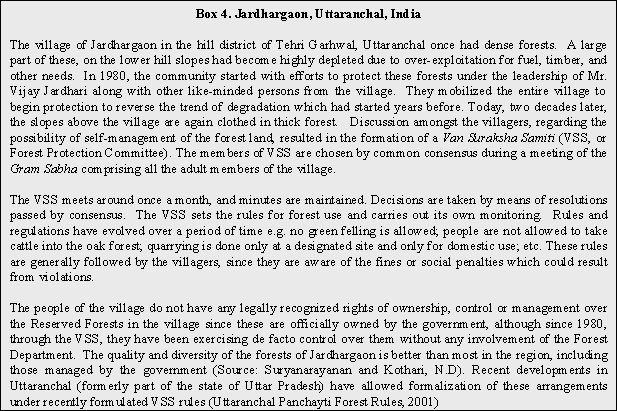
Autonomy and local level empowerment implies a capacity within local institutions to effectively monitor their own forest management and institutional decision-making processes. In practice, a lack of confidence in this is often the justification needed for government forest services to maintain their control over local forest management and governance by imposing overly complex FMPs, and externally driven monitoring arrangements on CFMs. Ironically, poorly resourced governments are rarely in a position to monitor effectively whilst many forest dependent communities have been able to evolve their own monitoring arrangements if given the opportunity to do so.
For example, user-led monitoring called “Participatory Resource Monitoring” in West Bengal can be a real and effective alternative to externally driven systems. In Participatory Resource Monitoring, a community monitors its own natural resources (e.g. forest growth; harvested products; NWFPs collected and sold and even biodiversity indicators such as insects found in the forest. The community also keeps their own records of these and uses this to manage the forest resource in a sustainable way by developing "check and balance" mechanisms. In West Bengal the Forest Department is now incorporating these findings for their own long-term planning (Dey, 2002, personal communication).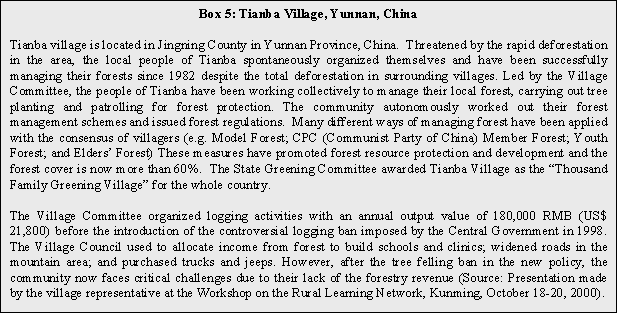
As a minimum requirement, FMPs for livelihood-oriented forest management will require the following to be clearly defined:
• forest boundaries
• resource assessment
• assessment of forest product needs
• use rights and responsibilities of members of the group
• benefit sharing arrangements
• minimum environmental standards
Many community forestry initiatives have been able to develop and adapt this simple model plan to their own circumstances. For example the planning guidelines for Bhutan describe the characteristics of simpler FMPs (Fig. 3).
Figure 3. Characteristics of community FMPs in Bhutan. Adapted from Forestry Extension Division (2003 draft) | |
Useful |
• Containing all the information needed by the Community Forest Management Group (CFMG) to manage their community forest • Not containing any extra information (not actually required for managing the community forest) • Including all the actual activities which the CFMG agree to implement |
Participatory |
• Prepared by the CFMG (or committee) with forestry staff as facilitators and trainers |
Understandable |
• Written in local language • Including maps, diagrams, charts and drawings to be easily understandable • Short and containing minimal text |
Flexible |
• Allow for annual monitoring and review of activities |
Realistic |
• Containing agreed responsibilities for implementation and procedures which the CFMG can follow |
Box 2 outlines the contents of a simple FMP (operational plan for Nepal). Similar, simple formats have been developed for other CFM situations. For example Box 6 shows an example of the simple table of contents for a participatory forest management plan developed in Cameroon. Whilst being more detailed than the bare minimum prescribed in the national level guidelines41, this is still simple enough to produce a plan which can be prepared and understood by local people and which is likely to be implemented.
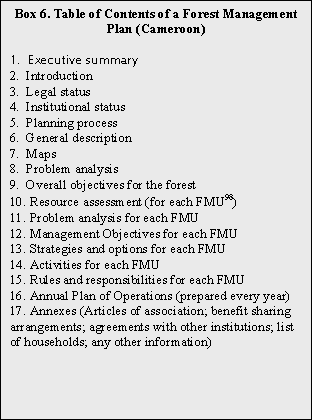
Many purpose-built methodologies for simple forest management planning techniques have been developed for a range of environmental and socio-economic situations. These allow forest management plans to be developed with simpler formats similar to some of those described in section 3.2.3 whilst building on locally evolved practices and knowledge and fitting within the current legislative framework for livelihood-oriented forest management.
Initiatives with jungle rubber management (Box 7) in Indonesia (under ICRAF42) CFMs with holistic management planning support based on indigenous knowledge in order to promote multi-purpose forest garden management systems. These initiatives are based on identifying, developing and implementing silvicultural techniques for mimicking natural succession of forest to local climax vegetation. This is not just ecologically credible but also culturally credible to local people.
CFMs selectively encourage the growth of valuable species in the forest succession process so that they are assured of good harvests the forest products they need. These approaches can only be effective by taking advantage of the amazing knowledge of local people on local vegetation including its use, propagation and management. It is relatively easy to generate confidence in these indigenous knowledge-based forest garden management systems because they can be easily woven into their traditional livelihood system. External extension services provide complementary advice on silvicultural techniques and are able to learn from the local management systems being developed in this way.
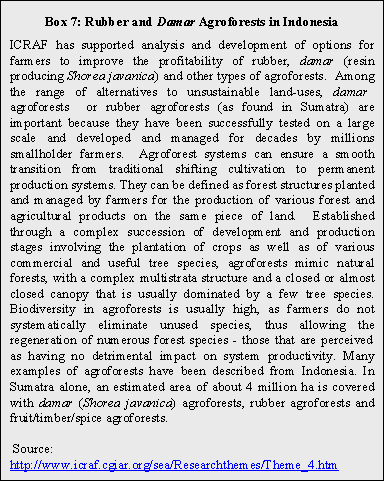
This approach which has been field-tested in Nepal44 and Vietnam45 is an example of iterative learning where forest users are supported in developing their own silvicultural or forest management systems most suited to their own particular needs and environment. The FMLG approach which was developed out of the Farmer Field School (FFS) methodology used in agriculture, is used to facilitate knowledge generation for multi-purpose community forestry. The approach assists forest users in developing the knowledge, critical skills and self confidence they need to make decisions about forest management based on their own experiments, observations and analyses. FMLG offers forest users opportunities:
• to analyse existing forest resources and future forest product needs
• to identify the opportunities for various forest management options including opportunities for income generation
• to analyse existing constraints
• to try out new forest management options on a small scale
• to act as a forum for exchanging ideas for the improvement of livelihoods
• to identifying common problems and encourage collaborative working
Identification of promising knowledge or techniques through experiments by forest managers may feed into the modification of their forest management plans as demonstrated in Nepal (Box 8) – hence the iterative process.
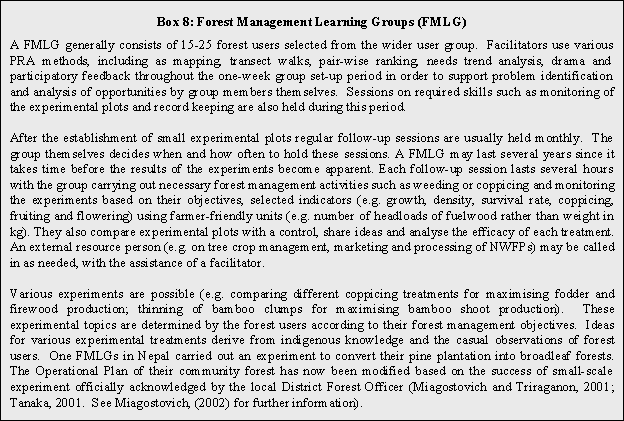
In conventional FMPs, forest inventory is an activity which requires considerable technical inputs and which can take a considerable amount of time and expense to carry out. In CFM there is a need for techniques which are more appropriate to the needs and capacities of local forest managers – especially for situations where timber production is not the major forest management objective. Much attention has therefore been given to the development of simple, participatory forest resource assessment methodologies for livelihood-oriented forest management.
A number of different aspects of forest resource assessment have been modified and tested to make them better suited to livelihood-oriented forest management including:
• forest resource assessment (covering the whole forest resource) rather than just timber inventory;
• participatory processes where forest users are actively carrying out the forest resource assessment themselves rather than forest technicians;
• simple, non-quantitative methods with emphasis on visual observations in the forest rather than accurate measurement;
• use of locally recognizable measurement units and classification systems rather than conventional inventory terms;
• presentation of information produced by forest resource assessment in a visual and graphic way to enable better interpretation of results by forest users; and
• linking of forest resource assessment with simple systems for identifying suitable silvicultural systems and estimated forest product harvesting levels.
The examples which follow have been selected to illustrate some of these aspects of participatory forest resource assessment.
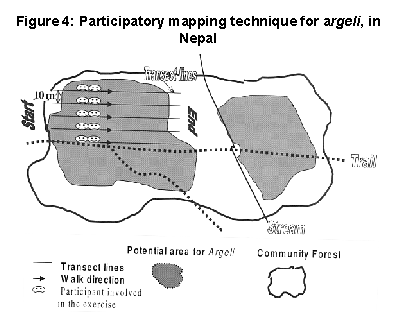
NWFPs are an important forest component in community forests in Nepal but their assessment for the purposes of determining sustainable harvesting regimes is normally rather vague – often a simple description of what NWFPs are present in the forest.
An attempt to develop a simple, yet more informative assessment system for one NWFP (argeli46) – used for paper making) was based on a series of steps:
• delineation of the growing area (by participatory mapping);
• systematic counting of clumps (on parallel transect lines);
• estimation of the availability of bark in each clump; and
• data analysis and calculation of sustainable harvesting levels.
Each of the steps was a collaborative exercise involving both local forest users and forestry field staff. A field manual47 was developed to guide each step and assist in the calculation of harvest levels.
At Arabuko-Sokoke Forest in Kenya48, 49, a pilot participatory forest management plan was developed with the villagers of Dida Village adjacent to the forest boundary. The main forest products which the villagers wished to utilize included house-building poles, fuelwood, medicinal plants, as well as foliage for butterfly farming and pollen sources for beekeeping.
It was found necessary to make an assessment of the availability of building poles of different categories so that villagers could determine sustainable harvesting systems for their utilization. 5 categories of poles were identified by the villagers. Each had a particular local name and use, and was distinguished by certain size parameters.
Figure 5: Local categorization of building poles, Dida Village, Kenya | ||
Local name |
Local Use |
Approximate dbh range |
Fito |
Horizontal wall runners |
< 4.0 cm |
Pau |
Vertical wall runners |
4.1-6.0 cm |
Mazio |
Roof support |
6.1-9.0 cm |
Kigingi (borito) |
Wall support |
9.1-13.0 cm |
Nguzo |
Fencing |
13.1-20 cm |
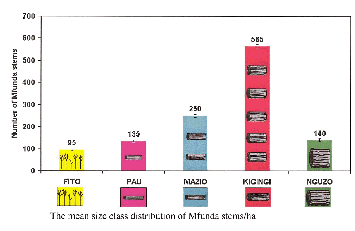
Small sample plots were laid out in the forest. No trees were actually measured inside these plots, but each tree was classified according to the categories shown in the table and the number of poles in each category was recorded for each plot. Histograms were then produced showing (for each of the main tree species) the availability of house building poles in different blocks of the forest assigned to the village. From this, villagers were able to estimate offtake levels for each category of pole and could develop local harvesting rules according to tree species and category of pole.
Most community forests in Nepal are important sources of forest products for the subsistence needs of members of the forest user group. After protection, such forests can become very productive with regular harvests of fuelwood, fodder, poles and some timber. A simple system for estimating offtake levels of fuelwood has been devised and has been widely used by both members of forest user groups and Forestry Department field staff (Branney, 1994). These “thumb rules” are based firstly on a visual assessment of the forest resource by forest users covering 4 main criteria including:
• forest type (for 3 main forest types found in the middle hills of Nepal);
• age (mature, pole-stage, shrubland, mixed);
• canopy density (dense, open, very open); and
• regeneration (abundant, few, none).
Based on these criteria, forest condition (good, average, poor) can be assessed using simple flow diagrams. For each condition, there are harvesting options e.g. singling, thinning, coppicing (or combinations of these) as well as an estimated annual yield per ha. This can be calculated for a forest block of a known area and depending on the expected harvesting cycle (i.e. how soon users expect to return to the same block for another harvest). Although a very simple system which can be used effectively with local people, further measurements have shown that the information on harvesting yields is reasonably accurate and well within the requirements for sustainable harvest levels (Maharjan 1998).
Most FMP formats for community-based enterprises officially accommodated in legislation require 100% pre-harvest inventory (e.g. Cameroon (draft)50, Brazil51, Bolivia52, and Nepal53). None of the formats are particularly simple and none of them extend beyond the traditional boundaries of forest management planning to encompass business planning despite the fact that this is an area where support and planning are critical to the success of the enterprise.
FMPs incorporating business planning have been tried under some pilot projects. For instance, the Social Forestry Development Project, Sanggau, Indonesia, provides guidelines for overall business planning for community-based timber enterprises, including infrastructure development and financial analysis. These elements are incorporated in the forest management planning support provided by the project54. Some FMPs for community forestry (Operational Plans) in Nepal specify the need of NWFP management, income generation and income distribution planning (Branney et al, 2001) although few have actually incorporated much specific information about such activities in the plan.
The GTZ-funded Social Forestry Development Project (SFDP) in West-Kalimantan has developed a simpler FMP format with the objective of making plans for small-scale commercial forest enterprises simple, effective and transparent (Schindele and Lux, 2001). These new FMPs not only need to be suitable for implementation by local CFMs, they also need to comply with current government regulations. Unfortunately, the government regulations which are derived from the concessionaire system require a level of complexity which is still not appropriate for local CFMs at village level to be able to address without additional support from forestry professionals. This leads to a contradiction where simpler FMPs are piloted and tested, but cannot be more widely used because of constraining legislation. Clearly there is a need for altered legislation to address this.
Probably there is less opportunity for FMPs for enterprise-oriented forestry to be developed out of existing local knowledge and experience compared with plans for livelihood-oriented forest management. In many countries, forest nationalization at some point in the past has alienated local people from having access to timber resources from adjacent forests without the involvement of government forest services whilst subsistence needs have often continued to be met on a de facto basis even after nationalization.
In some countries such as Bolivia55 and Myanmar56, the preparation of FMPs is the responsibility of the supervising foresters rather than the CFMs. This is partly because the required systems are too complicated for CFMs to implement, but unfortunately this also removes the opportunity for FMPs to be prepared through a participatory process and to evolve through the experiences and local knowledge of the forest managers.
Analysis of the numerous FMPs collected for the study which led to this working paper shows few examples of simpler FMPs for small-scale forest enterprises. It appears that simplification of FMPs for both commercial timber or commercial NWFP enterprises (whether community based or not) is not easy, nor always desirable. There is a risk that excessive simplification of FMPs for industrial logging can lead to deforestation57. The requirements of such plans make them inherently more complicated.
FMPs for forest enterprises may require additional such as cost-benefit analysis, yield projections, marketing, assistance from financial institutions (e.g. bank loans), labour management and infrastructure development (e.g. office, processing facilities, logging roads). It does not appear to be realistic to incorporate all these elements into FMPs for commercial enterprises whilst also keeping the plans very simple. However, it does appear that FMPs for timber-enterprises are used in many community forestry projects without having analysed the comparative disadvantages which CFMs are likely to have in a business environment. For example, since FMPs for some commercial forest enterprises cannot be easily simplified, then CFMs should at least be able to understand what the process for formulating each component of the FMP entails before they invest their time, efforts and money into it, since this may affect the viability of the enterprise. Resource-poor forest managers might choose to undertake a commercial timber or NWFP enterprise and even bear the costs of complex and costly FMP as long as they are convinced that it will be profitable for them.
A number of simple planning techniques have been developed which can be used as part of the management plan preparation methodology for enterprise-oriented forest management plans.
Originally developed in Nepal and Vietnam for supporting small-scale NWFP enterprises58, Market Analysis and Development (MA&D) methodology (Lecup and Nicholson, 2000) has also been applied in Laos, China, The Gambia and Uganda and there are plans to adapt the methodology in Latin America59. The MA&D emphasizes a holistic forest management planning and business planning process.
The strength of the MA&D process is the high degree of community involvement from the outset in the planning and design of the enterprise and the business plan. Emphasis is on resource sustainability; market sustainability; social & institutional sustainability and technical sustainability. MA&D assists communities in directly linking forest management and conservation activities to income generating opportunities by providing support for investigating the market environment.
The MA&D process consists of three phases (see Box 9). In the first phase community members assess the existing situation and make a short-list of promising products and services for potential enterprises while taking into account four important aspects of sustainability (resources, market, social & institutional and technical). In the second phase detailed feasibility studies are carried out to assess the economic, ecological, social and technical viability of each of the short-listed products. The information obtained enables community members to make the final selection of the most viable enterprises and prepare business plans. In the third phase community members develop their enterprise development plan (business plan). MA&D has also proven to be successful for several applications60 beyond NWFP enterprises
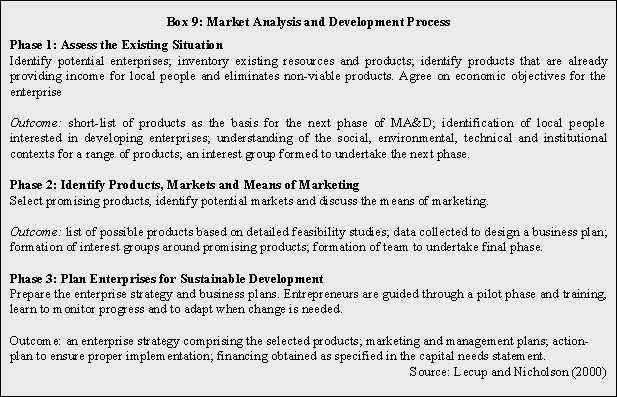
Simpler tools and measuring systems
Whilst it may be necessary for forest management plans for commercial forest enterprises by CFMs to be relatively complex when compared with the simple plans for livelihood-oriented forestry, it is possible to simplify some of the tools and measurement systems which are used during forest resource assessment and preparation of the management plan.
For example, when measuring tree diameters, in Karnataka, India61 a colour-coded calibrated calliper is used. This means that as every tree is measured it can immediately be assigned to a diameter-class according to the colour recorded by the measurer. This not only reduces the need for tedious calculations based on diameter measured with tapes, but it also means that local people can be actively involved in carrying out the measurements, even if they are not literate or numerate. A similar system has recently been developed in Vietnam62 where a colour-coded diameter tape was prepared and was very effectively used by villagers for assigning trees to diameter classes without the need to be able to read numbers.
In Bhutan63, a simple wedge prism has been used in community forest stands to get an initial estimate of forest basal area (with practice these can even be used by villagers). Only stands where the basal area is found to be above a certain minimum level are required to be inventoried later using conventional measurement plots (because only these stands have sufficient timber volume for harvesting). This saves a considerable amount of time and effort during management planning.
Other, more sophisticated equipment can be utilized to reduce the time and effort required for management plan preparation, as well as ensuring that participatory processes are not lost. For example, a GPS is being effectively used in Bhutan for carrying out boundary surveys with local villagers. The boundary of a forest can be walked by a forest technician carrying a GPS accompanied by villagers who can show exactly where the boundary lies. The data can then quickly be downloaded onto a laptop and superimposed onto a scanned topo map to produce a boundary map which is then printed out – within a very short space of time. A map is therefore produced which the villagers immediately recognize as “their forest” whilst also saving a considerable amount of time during the survey process. An additional advantage of this system is that changes and modifications to the boundary can be easily accommodated and it is also easy to survey internal features e.g. footpaths which it would otherwise be too time consuming to do.
FMPs for individual forest owners are discussed here because they are also concerned with the developing simpler types of FMP.
Many of the FMP formats used by individual small-scale forest entrepreneurs collected during this study strongly emphasize silvicultural planning for ecologically sustainable forest management. As with FMPs for commercial forest enterprises, aspects of business planning are also generally weak.
A number of Latin American countries have made specific provision for FMPs for individual small-scale forest managers. This is mainly because individual ownership of forests is more common in the region compared with Africa and Asia, although an example from Bhutan is also described here. The FMPs described below are not necessarily simple or cheap compared with the expected returns from the small-scale forest managers’ point of view.
In Bolivia, forest concessionaires, private landholders as well as indigenous communities have to prepare FMPs for commercial forestry management. FMPs64 for commercial forestry by individual forest owners (up to 200 ha) require 3 maps65, a general management plan including 100% inventory (including number of trees, basal areas and volumes by species and by forest types), calculation of annual allowable cut, and annual operational plans. Similar FMPs are used in Chile (up to 150 ha66), Costa Rica (with sampling inventory and 100% pre-harvest inventory67), Guatemala68, Brazil (up to 500 ha69) and Paraguay (up to 50 ha with 10% sampling inventory70).
![]()
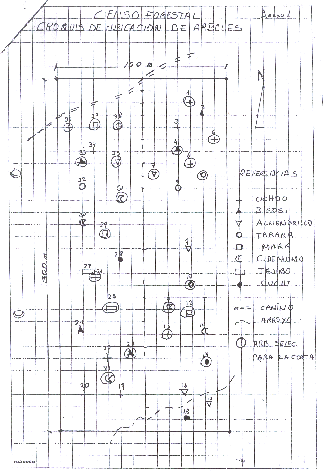
In Bolivia, a simpler FMP system for small-scale enterprises is administered under regulations called “exception regimes”. These promote a progressive adjustment of people’s forest use practices depending on the scale of the operation e.g. small farmers are allowed to log timber in areas less than three hectares without the presentation of land-use plans at the parcel level providing that they produce a simple hand-drawn sketch for cutting (see fig. 6), a list of trees by species with diameter and heights, and follow minimum environmental guidelines71. At a slightly higher level, small-scale timber producers are allowed to carry out forest operations only with a logging annual plan (Pacheco, 2001). In Guatemala, forest managers are allowed to log without a land use plan in coniferous forests smaller than 5 ha on the preparation of a similar sketch and conditions as required in Bolivia72.

In Argentina73, plantation and enrichment of natural forests smaller than 10 ha and pruning, thinning and coppicing of forests up to 50 ha does not require a management plan. Individual small-scale forest owners are also allowed to jointly register their afforestation activities with other owners when each of them has a forest smaller than 5 ha. They are eligible to apply for subsidies for reforestation and forest enrichment after the registration74. In Chile, individual small-scale forest owners can apply for credit for the purpose of reforestation of degraded land or forests whose surrounding areas are degraded. Under these schemes forest managers are supposed to follow the management guidelines specified in the application form but they do not need to prepare a forest management plan apart from a sketch map (for up to 5 ha) or a forest map with the application forms75. However, they later need to prepare “Norms for management76” including a 100% inventory in time for harvesting of mature forests.
In many countries it appears to be common for there to be no requirement for a FMP for forest utilization for small-scale private owners (usually less than a particular size threshold). E.g. in Vietnam, no inventory is required for the use of Protection Forests by individual forest managers but instead the use of these forests is regulated through the need to adhere to a compulsory standard77.
In Bhutan, a simple system is still under development for FMPs for private forestry78 where forest owners have prescribed legal rights to utilize timber from their forests once they are registered, but these must be managed according to a private forestry agreement or a private FMP agreement (see fig. 7)
Figure 7: Private forestry in Bhutan | |
Type of plan |
Criteria |
Private forest agreement |
• Private forests with naturally grown trees up to an area of 0.5 acres • Private forests with planted trees up to an area of 5.0 acres |
Private forest management plan agreement |
• Private forests with naturally grown trees with an area larger than 0.5 acres • Private forests with planted trees of an area greater than 5.0 acres |
The FMPs and forest management agreements in Bhutan for private forestry consist of a series of forms which have to be completed by the landowner. These require each stand of trees to be described and the number of trees counted (but no actual measurements are required). In addition, a surveyed map is also needed clearly showing the boundaries of the forest.
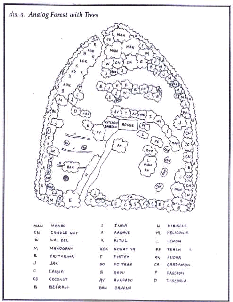

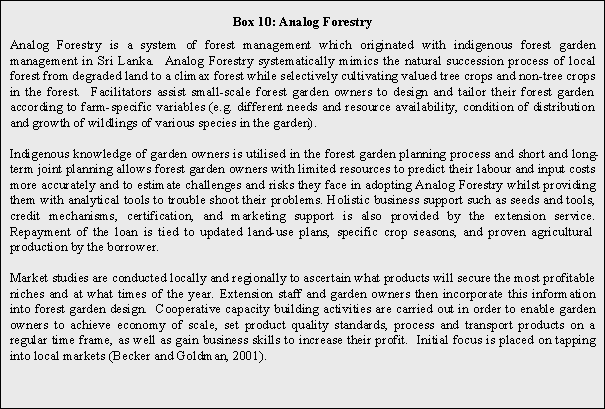
Analog forestry (Box 9, fig. 8) is an example of a simple planning technique which has been used to assist with applying indigenous knowledge and combining it with comprehensive business planning support to strengthen forest garden management as a financially sustainable small-scale business enterprise. It has mostly been applied to private forestry situations, although it may also be applicable for CFMs. Under the system, the extension agency provides various types of business support such as credit, joint marketing and certification of Analog Forestry products.
27 The list of names of 15 valuable species is given in the manual.
28 The list of diameter limit for harvesting valuable species is given in the manual. If regeneration is not present, harvesting can occur only if enrichment planting takes place. It there is regeneration over 1.5m (or a man height) in medium density, harvesting is possible. In a pure young stand (diameter between 10 and 20 cm) of valuable species without regeneration, harvesting is possible if the distribution of remaining valuable trees is satisfactory. This operation is a thinning to favour the elite trees for high quality timber production.
29 A three-year management plan is required for the period of Preliminary Community Forest Management Agreement (PCFMA). A five-year management plan is required after Community Forest Management Agreement (CFMA) is made.
30 Local forest user groups called as such in Gambia
31 Information on the location of the community forest, road network, natural resource, land use distribution and planed forest management activities are shown in this map (the scale of 1:10000). These information are collected through PLA exercises such as transect walk and participatory mapping. A photocopy of 1:50000 map should be also submitted to indicate the location of the village(s) within a district (Field Manual, and Reeb, 2002, personal communication).
32 It consists of brief over view of the local forest history, names of the officers of the government institutions involved, names of the committee members and their position, village population information, the name of village head, review against previous report (e.g. the status of vegetation, regeneration and given damage to the forest (qualitative, rough assessment), and management options (e.g. firebreak establishment, tree planting, deadwood utilisation, nursery activity, regular patrol, regular meeting and beekeeping).
33 The size of a community forest can be very big. For example, there are some community forests of 70,000 ha in Mexico (Negreros, 2002, personal communication).
34 The Land Act (No.6 of 1999) and The Village Land Act (No.7 of 1999)
35 The inspection is carried out to identify, clarify and assess forest boundaries, vegetation zones, special sites in the forest, change of the forest condition in the last 50 years (e.g. streams, wildlife, forest use – grazing, wood extraction, hunting, beekeeping, mining, and identification of degraded areas), forest users, forest- damaging practices, new use of the forest, forest ownership and management status, existing rules and existing best forest managers.
36 CBFM guidelines include the following activities as examples of actions: planting seedlings around a degraded spring to encourage the return of water; filling gullies with stones; cutting and planting suckers in a burnt area without regeneration of useful species; using a bare area for private plantations on payment of a fee; discouraging certain species by permitting free thinning to encourage growth of another species.
37 There are various forms of CBFM in Tanzania with different formal registration processes. A district register of forests is required at the District Council level where the community independently manages the forest as a declared or gazetted VFR, or where only part of the community is involved, as with a Group Forest Reserve. A joint management agreement (JMA) is fixed between the Central Government and the community where Government designates the community as manager of a National Forest Reserve. A JMA is also fixed where Government and the community agree to manage a National Forest jointly, sharing decision-making and the work of management as co-managers - usually meeting as a ‘Joint Management Committee’ to make plan and take decisions.
38 Simple questions are used for the assessment, e.g. “Have the in-forest dwellers left?”, “Has cultivation in the forest ceased?”, “Are cattle and people trails closed?”, in order to assess the effectiveness of the provisional CBFM arrangement.
39 Guideline for Forest Inventory (2000). Ministry of Forests and Soil Conservation, Kathmandu
40 Reglamento General de la Ley Forestal (Decreto Supremo 24453, 1996: Articulo 69, III).
41 Manual of the procedures for the attribution and norms for the management of community forests (MINEF, 1998)
42 International Centre for Research in Agroforestry
43 The FMLG approach was developed by RECOFTC (Regional Community Forestry Training Centre for Asia and the Pacific, Bangkok) with the support of The Forests, Trees and People Programme (FTPP) of FAO.
44 Field tests in Nepal were carried out in conjunction with Nepal-Swiss Community Forestry Development Project; FAO Hills Leasehold Forestry and Forage Development; Women Acting Together for Change (WATCH); Nepal-Australia Community Resource Management Project; the Federation of Community Forestry User Groups of Nepal (FECOFUN); and the Community and Private Forest Division of the Department of Forests (CPFD)
45 Field tests in Vietnam were carried out in conjunction with The Social Forestry Development Project (SFDP) Song Da; the Mountain Rural Development Programme (MRDP); the Social Forestry Support Programme (SFSP); the Sustainable Management of Resources in the Lower Mekong Basin Project (MRC); and the project “Afforestation in Bac Giang, Quang Ninh and Lang Son Provinces” (KFW3).
46 Argeli (Edgworthia gardneri – a shrub, the bark of which is used for making paper)
47 Nepal-Swiss Community Forestry Project (2001)
48 The Arabuko-Sokoke Forest Management and Conservation Project was funded by the European Union.
49 Brunt (2001)
50 Manual of the procedures for the attribution, and norms for the management, of community forests (Chapter 6.2), Ministry of the Environment and Forestry
51 Seção IV, Instrução normativa No. 4 (4 March, 2002), Gabinete Do Ministro
52 Normas tecnicas para la elaboración de instrumentos de manejo forestal comercial (inventarios, planes de manejo, planes operativos, mapas) en tierras comunitarias de origen, Resolución Ministerial No 136/97, Ministerio de Desarrollo Sostenible y Medio Ambiente.
53 Malla et al (2002)
54 Schindele and Lux (2001), Forest Management Planning, Guidelines for Community Based Forest Management, SFDP
55 The Article 27 of Forest Law No 1700 (1996) and the Paragraph 1 of the Article 69 of Regulation (Supreme Decree 24453)
56 Community Forestry Instruction of Myanmar specifies the users’ group has to draw up a management plan according to the form prescribed by the Forest Department, and forwarded to the District Forest Officer for confirmation. Advice of responsible forest officer will be taken in the preparation of the plan (clause 14). On the other hand, the guidelines on “Appropriate Forestry Practices” for the Forestry Sector of the Watershed Project in Myanmar states “Management Plan will have to be prepared by the Forest Department in consultation with the community” (p.2) for community forestry establishment.
57 Such deforestation is reported in Chile (Prado, 2002, personal communication), for example.
58 The MA&D methodology was developed by FAO/FONP in collaboration with the Regional Community Forestry Training Centre (RECOFTC). Other institutions and organizations that supported the development of the MA&D methodology and instruction manual include the World Conservation Union (IUCN), Netherlands Development Assistance (NEDA), the Centre for International Forestry Research (CIFOR), and the Netherlands Development Organisation (SNV).
59 Collaborations with the following institutions/initiatives are on going in Latin America: Joint UNEP-WCMC and ODI project on "Commercialisation of Non-Wood Forest Products: factors of Success and Failure", with special reference to Bolivia, Mexico and Nicaragua; UNCTAD BIOTRADE and ITC Geneva joint Trade Facilitation Programme (TFP), the "Bolsa Amazonica" initiative in several South American countries as well as Biocomercio Sostenible in Colombia; CATIE (Centro Agronómico Tropical de Investigación y Enseñanza) in Central America: MA&D will be used in Project CATIE/FOMIN in pipeline: PyME's Forestales en Guatemala, Honduras y Nicaragua; Andes Group of Conservation International (Vilcabamba-Amboró conservation corridor), and; Instituto Alexander Von Humboldt and its Biocomercio Sostenible program in Colombia and GEF-Andes project: (proposal)
60 Planning horticultural enterprises (SCTC, Sichuan, China), Agro-forestry marketing initiatives (Vietnam), Planning of village-based eco-tourism activities (SNV, Nepal), Poverty alleviation by identifying rural - based micro enterprises in all sectors of the economy (MEDEP/UNDP, Nepal), namely
61 This technique was used by the Western Ghats forestry project (1993-99)
62 Under the GTZ supported SFDP Song Da (Social Forestry Development Project)
63 Community Forest Manual for Bhutan (draft), (2003)
64 Normas tecnicas para la elaboración de instrumentos de manejo forestal (censos comerciales, planes de manejo, planes operativos y mapas) en propiedades privadas con superficies iguales o menores a 200 hectareas en zonas tropicales y subtropicales, Resolución Ministerial No 132/97, Ministerio de Desarrollo Sostenible y Medio Ambiente. According to Pacheco (2001), forest logging in private properties equal or less than 200ha, by which land owners are wishing to log timber were exempted from the Forest Management Plan. This regime lasted longer than expected and was extended until August, 1998.
65 The 3 maps are namely, 1. Territorial location base map, 2. Vegetation and tree cover map, and 3 operational map of harvest and silvicultural treatment.
66 Norma de manejo aplicable al tipo forestal siempreverde (corta de regeneración), CONAF
67 Acuerdo No 27388-MINAE (Principio No 7)
68 The forest management planning requirements in Guatemala are differentiated into 7 categories according to the size of the forest and its vegetation; Broadleaf forest<45ha, >45ha, Coniferous forest <5ha, 5-15ha, 15-45ha, >45ha, and Mangrove forest.
69 Under “Plano de Manejo Florestal Sustentável de Uso Múltiplo de Pequena Escala” (PMFS Pequena Escala), Instrução normativa No.4 (4 March, 2002)
70 La Resolución No 07/2002
71 These guidelines are; following minimum DBH (Diameter at Breast Height) for the selection of felling trees, only cutting trees reported in the map, no disturbing of streams especially during felling operations, leaving at least 20% of the trees above cutting DBH, no hunting of wildlife according to Procedimientos para la autorización de aprovechamiento forestal para pequeños propietarios (Instructivo técnico – operativo, OLSCZ – 006/2000, Superintendencia Forestal, Santa Cruz)
72 In Guatemala, tree cutting is regulated by annual allowable cut in volume. 100% pre-harvest inventory (>25cm DBH) is required for all the categories of forest management plans. Establishment of sample plots is required in order to estimate annual volume increase apart from coniferous forests smaller than 5 ha (Formato plan de manejo 83-86, - 99, Instituto Nacional de Bosque.
73 Conceptos básicos para la presentación de proyectos en forma individual, Resolución No 22/2001
74 Resolución 168/2000, Dirección de Forestación
75 Estudio tipo de acreditación de ejecucion de actividades de forestación para pequeños propietarions forestales, Estudio tipo de reconosimiento de suelos forestables para paqueños propietarios forestales, Estudio tipo de calificación de terrenos de aptitud preferentemente forestal para pequeños propietarios forestales, Corporación Nacional Forestal (CONAF), Gobierno de Chile
76 Norma de manejo aplicable tipo forestal siempreverde (corta de regeneración) , CONAF
77 Regulation of 11 January, 2001 (No. 08/2001/QD-TTg) on Management of Natural Forests Classified as Special-use and Protection Forests and as Natural Production Forests specifies the standard requirements, such as: 1. Watershed protection forests must form a contiguous, multi-layered forests with a mixture of species and ages and also have a stable root system. The crown cover must be over 0.6; 2. The main belts of wind and sand breaks must be at least 20m wide. The main belt and subsidiary forest belts have to form a consolidated block. Forests protecting agricultural production and other economic enterprises shall be planted in bands or lines. Forest belts or bands consist of many trees close to each other, enabling the canopy to close both horizontally and vertically; 3. Coastal wave breaks must have at least one forest belt of several lines of trees with contiguous canopy and with a minimum width of 30m. The belts should be oriented at an angle in relation to the direction of major waves; and 4. Protection forests for ecological and landscaping purposes contain forest bands of trees scattered in residential, industrial and tourism areas. Such forests and trees are to restrict air pollution, create a clean environment and also provide an environment for recreation and tourism (Article 22). Traditional joint forest management system is out of the scope of current legal frameworks in Vietnam even though many successful examples of Community Forestry exist under the discretion of local governments and many forests are under de facto community group management
78 Forest Extension Division (2002) Private forestry manual for DzFOs and DFOs (2nd draft).